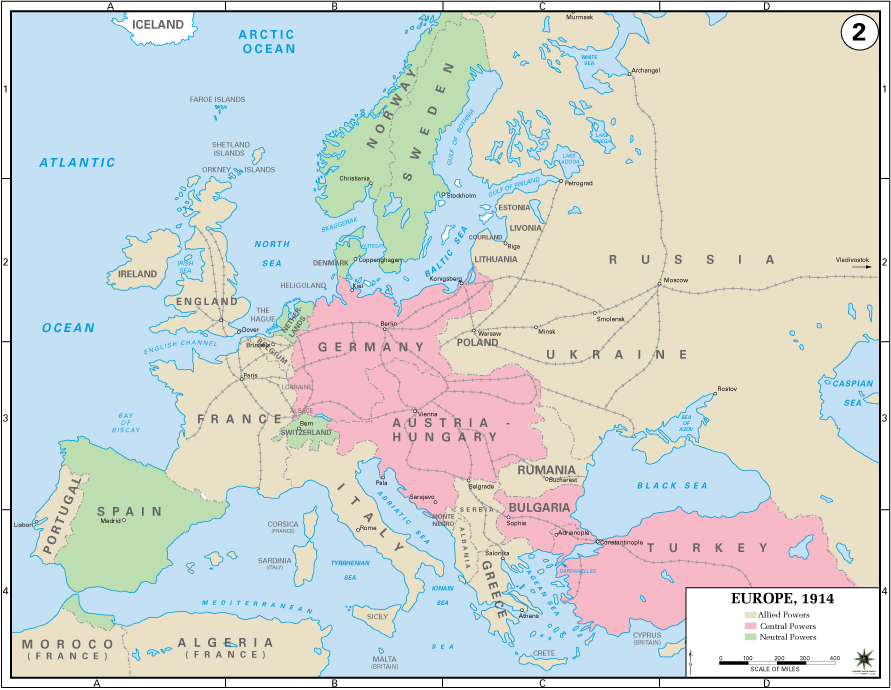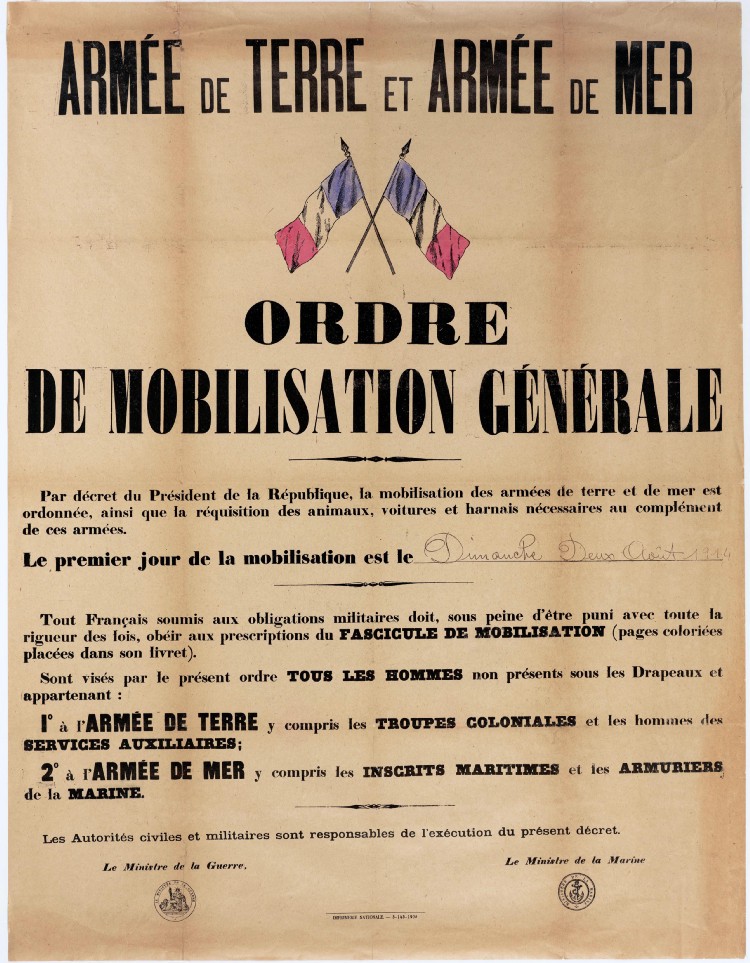● ● ●
When
the guns opened fire in the summer of 1914 no one, not even
the generals, really knew what to expect. The last general
European war had been fought in 1815, a year in which the
military state of the art was represented by the Brown Bess
musket. With this weapon, generally considered to have been
the finest of its type, a well-trained soldier could load
and fire two or three rounds a minute. The effective range
of the Brown Bess and similar smoothbore muzzle-loading
flintlock muskets was about 80 yards. As for the artillery,
in 1815 it consisted mostly of cast bronze muzzle-loading
smoothbore cannon of various types, such as the French
12-pounder field gun. This weapon had an effective range of
about 1,000 yards with solid shot and 500 yards with
canister. Its rate of fire was one or two rounds a minute.
The main weapons of the cavalry arm were the sword, the
saber and the lance.
The
armies that employed these weapons were of modest size. At
Waterloo about 75,000 French troops fought some 120,000
allied troops. The battles of the Napoleonic era were,
indeed, larger and more sanguinary than those of the
preceding Seven Years War. But a soldier of the army of
Frederick the Great would not have felt entirely out of
place at Austerlitz or Borodino. Between the general
adoption of the flintlock musket around 1700 and the defeat
of Napoleon, military technology had remained relatively
stable. Such improvements as occurred were incremental, for
instance the replacement of wooden musket ramrods by more
durable iron ones.
Most of the
states that fought the wars of that era still had roots in the
feudal and absolutist past. What would come to be called the modern
nation-state was best exemplified by France, with profound
implications for the art of war. The French Revolution gave birth to
a concept of national citizenship embodying both rights and duties,
and foremost among the latter was the duty of bearing arms in
defense of the nation. The citizen-soldiers of the French armies
were not mercenaries or press-ganged peasants, as in the Russian,
Prussian and Austrian armies. The rigid discipline and draconian
punishments that kept the soldiers of those states under control
were not necessary to make French soldiers fight. Patriotic ardor
powerfully reinforced traditional military discipline, and this was
reflected in new, flexible battlefield tactics that Napoleon was to exploit to
the fullest. And wherever the French armies marched, they brought
with them the ideas of the French Revolution—nationalism prominent
among them.

Europe
on the eve of the Great War (Department of History, USMA West Point)
Between 1815
and 1914, the growing national consciousness of its peoples
transformed the face of Europe. The Greek War of Independence, the
Polish revolts, the revolutions of 1830 and 1848, Italian and German
unification, all in their various ways undermined the old order.
This was particularly true as regards the multinational Russian,
Austrian and Ottoman empires. The Ottoman Empire's gradual decline
was a major source of European tension in the second half of the
nineteenth century, and the Habsburg Monarchy's fear of South-Slav
nationalism was a major contributor to the crisis that led to war in
1914.
War in the age
of the nation-state meant national mobilization and it was the
Industrial Revolution, advancing pari passu with nationalism, that
had made this possible. The growth, development and diversification
of industry—coal and oil, steam, steel, electricity and
chemistry—provided the material means to arm, equip, transport and sustain the
new mass armies. National conscription was managed by the
administrative apparatus of the modern state. The railroad and the
telegraph facilitated the mobilization and movement of armies. And
the great increase in the population of Europe between 1815 and 1914
supplied vastly more manpower for the armed forces.
Thus by
1914 the muskets of Waterloo had been replaced by bolt-action magazine rifles (rate of fire 6-8 rounds per
minute, effective range 800-1,000 yards) and the machine
gun. Smoothbore muzzle-loading cannons had been replaced by
breech-loading, recoil-stabilized field guns and howitzers
firing high-explosive and shrapnel shells to ranges up to
10,000 yards. In the cavalry arm, though the sword and lance
still held sway they were now supplemented by rifles and
machine guns. And the armies themselves were far larger. In
1914 France mobilized nearly 3 million men to bring its
peacetime army of about 800,000 up to war strength. The
mobilized German Army contained 4.5 million men. What would
happen when such gigantic armies clashed, no one could say.
Nevertheless it was the business of the generals and general
staffs who controlled these forces to plan for war. In
Germany, Austria-Hungary, France and Russia this planning
proceeded on the assumption that the impending war would be
decided in a single campaign of several months. There were
reasons to think that modern Europe could not sustain a long
war. Many people felt that Europe’s economic
interdependence, the vast cost of modern war and, perhaps,
the social unrest accompanying it would soon bring any
fighting to a halt. So, having read their
Clausewitz, the
general staffs of the major continental powers thought and
planned in terms of decisive battle.

The announcement of French
mobilization, 1 August 1914
More
precisely, they planned in terms of a series of
battles whose cumulative effect would be decisive. Military leaders
perceived that no single battle would determine the outcome
of the next war. Their planning thus focused on the
mobilization and initial deployment of their forces. All the
major European powers, Britain excepted, employed a similar
military system. Their peacetime armies were relatively
small, consisting of long-service officers, NCOs and
soldiers whose main business was to train the annual intake
of conscripts. These latter served for two or three years,
afterwards passing into the first-line reserve where they
remained for six or eight years. Thereafter they passed into
the second-line reserve, called the Territorial Reserve in
France and the Landwehr in Germany. Upon mobilization
the first-line reservists would be used to fill out the
units of the active army and to form additional units. The
second-line reservists would be formed into units for
employment on subsidiary duties: rear-area security,
guarding prisoners of war, garrisoning fortresses, manning
quiet sectors of the front, etc. By this means an army of
millions could be raised in three weeks to a month.
Prewar
military planning thus concerned itself with two problems:
(1) mobilization and organization of the army; (2) its
deployment to the zone of active operations. It was the
second problem that most exercised the minds of the general
staffs. After reporting to their regimental depots,
mobilized reservists would be uniformed, equipped,
armed and organized into units. But then they would have to be
transported by rail to the zone of operations. The
complications involved in this process were formidable. All
general staffs included railway sections whose specialists
concerned themselves exclusively with the rail scheduling
necessary to bring off a smooth deployment. In 1914 the
German Army’s western deployment required 11,000 troop
trains. At the height of the effort, trains were crossing
the Rhine River bridges at two- or three-minute intervals.
Men
realized that a mistake made in the initial deployment of
the army could not be rectified. Millions of soldiers with
all their horses, guns, ammunition, supplies and impedimenta
could not summarily be moved from place to place like
counters on a game board. Getting the initial deployment
right thus became the focus of prewar planning. The most
famous example is the German
Schlieffen Plan, that famous right hook—which
actually was a scheme of deployment, not a battle plan. The Chief of the Great
General Staff, General von Schlieffen, poring over his maps
at the turn of the century, sought sufficient space for the
western deployment of the German Army in full strength. His eye fell
inevitably on Belgium, “the cockpit of Europe.” There a
powerful attacking force would find ample ground on which to
array itself, pressing down
the Channel coast into France, turning the left wing of the
French army in a series of engagements whose cumulative
effect would bring decisive victory south and west of
Paris.
Similar planning had been going on in the offices of all the
general staffs of the European powers. Now war had come; the military
plans thus developed, the military instruments
thus forged, were about to be tested in battle.



